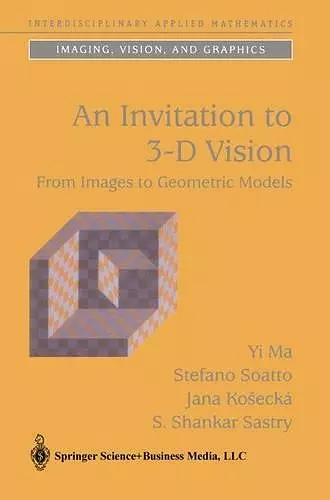An Invitation to 3-D Vision
From Images to Geometric Models
Stefano Soatto author Yi Ma author Jana Kosecká author S Shankar Sastry author
Format:Paperback
Publisher:Springer-Verlag New York Inc.
Published:24th Nov '10
Currently unavailable, and unfortunately no date known when it will be back

Springer Book Archives
This book is intended to give students at the advanced undergraduate or introduc tory graduate level, and researchers in computer vision, robotics and computer graphics, a self-contained introduction to the geometry of three-dimensional (3- D) vision.This book is intended to give students at the advanced undergraduate or introduc tory graduate level, and researchers in computer vision, robotics and computer graphics, a self-contained introduction to the geometry of three-dimensional (3- D) vision. This is the study of the reconstruction of 3-D models of objects from a collection of 2-D images. An essential prerequisite for this book is a course in linear algebra at the advanced undergraduate level. Background knowledge in rigid-body motion, estimation and optimization will certainly improve the reader's appreciation of the material but is not critical since the first few chapters and the appendices provide a review and summary of basic notions and results on these topics. Our motivation Research monographs and books on geometric approaches to computer vision have been published recently in two batches: The first was in the mid 1990s with books on the geometry of two views, see e. g. [Faugeras, 1993, Kanatani, 1993b, Maybank, 1993, Weng et aI. , 1993b]. The second was more recent with books fo cusing on the geometry of multiple views, see e. g. [Hartley and Zisserman, 2000] and [Faugeras and Luong, 2001] as well as a more comprehensive book on computer vision [Forsyth and Ponce, 2002]. We felt that the time was ripe for synthesizing the material in a unified framework so as to provide a self-contained exposition of this subject, which can be used both for pedagogical purposes and by practitioners interested in this field.
From the reviews:
"Computer vision is invading our daily lives … . Covering all the aspects would be too vast an area to cover in one book, so here, the authors concentrated on the specific goal of recovering the geometry of a 3D object … . The 22 pages of references form a good guide to the literature. The authors found an excellent balance between a thorough mathematical treatment and the applications themselves. … the text will be a pleasure to read for students … ." (Adhemar Bultheel, Bulletin of the Belgian Mathematical Society, Vol. 12 (2), 2005)
"This is primarily a textbook of core principles, taking the reader from the most basic concepts of machine vision … to detailed applications, such as autonomous vehicle navigation. … It is a clearly written book … . Everything that is required is introduced … . an entirely self-contained work. … The book is aimed at graduate or advanced undergraduate students in electrical engineering, computer science, applied mathematics, or indeed anyone interested in machine vision … . is highly recommended." (D.E. Holmgren, The Photogrammetric Record, 2004)
"This very interesting book is a great book teaching how to go from two-dimensional (2D)-images to three-dimensional (3D)-models of the geometry of a scene. … A good part of this book develops the foundations of an appropriate mathematical approach necessary for solving those difficult problems. … Exercises (drill exercises, advanced exercises and programming exercises) are provided at the end of each chapter." (Hans-Dietrich Hecker, Zentralblatt MATH, Vol. 1043 (18), 2004)
"This book gives senior undergraduate and beginning graduate students and researchers in computer vision, applied mathematics, computer graphics, and robotics a self-contained introduction to the geometry of 3D vision. That is the reconstruction of 3D models of objects from a collection of 2D images. … Exercises are provided at the endof each chapter. Software for examples and algorithms are available on the author’s website." (Daniel Leitner, Simulation News Europe, Vol. 16 (1), 2006)
ISBN: 9781441918468
Dimensions: unknown
Weight: unknown
528 pages
Softcover reprint of hardcover 1st ed. 2004